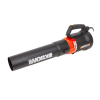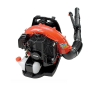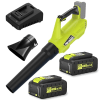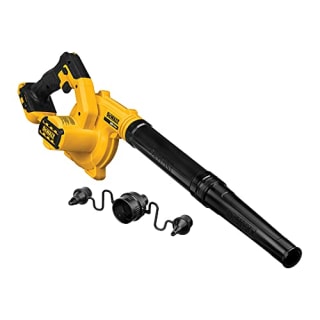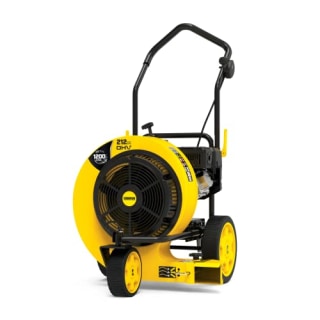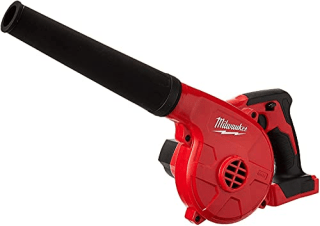While many people look forward to fall foliage, they don’t necessarily want fallen leaves all over their yard. And while raking the leaves into a jumpable pile in your backyard can seem tempting, the work behind it can be a hassle. Instead, many people rely on leaf blowers to tidy up their lawns and avoid overexerting themselves.
But a leaf blower doesn’t just help you clean up fallen leaves. It can be a good tool for clearing your porch and walkways of accumulated leaves or dust and cleaning up your garage after a project. These gardening tools can also remove grass clippings after mowing your lawn and clean up debris on sidewalks, driveways and other hard surfaces.
With several types of leaf blowers, finding the right one depends on how you plan to use it. We consulted lawn care and landscaping experts for tips and recommendations to help you determine what you should consider before purchasing a leaf blower.
SKIP AHEAD How we picked the best leaf blowers | 7 top-rated leaf blowers | Should you get a handheld or backpack leaf blower? | Meet our experts | Why trust NBC Select
How we picked the best leaf blowers
Anyone with trees, shrubs or other plant material that drops leaves, seeds and fruit in their yard can benefit from a leaf blower, says Michael Pugh, the owner of Virginia-based Commonwealth Landcare Inc. But they’re not limited to yards: As mentioned, leaf blowers can also clean balconies that may collect debris from surrounding trees. We asked landscaping experts what you should remember when shopping to help you find the best leaf blower to suit your needs.
- Price: Candidly, leaf blowers can be an investment — the prices generally range anywhere from $75 to well over $200 for an electric leaf blower, $150 to $300 for a handheld gas blower and $250 to upwards of $700 for a backpack blower. The experts we spoke with agreed you really shouldn’t go lower than $75, as the power will likely not be strong enough to do much of anything.
- Electric or gas: Leaf blowers are either electric (aka battery-operated) or powered by gas. The former tends to be quieter and lighter, while the latter tends to be more powerful, according to Pugh. For most homeowners with average-sized yards, our experts agreed that an electric model will be most cost-effective and easier to use. Those with larger properties or who need to use the tool for prolonged periods may be better off with a gas blower.
- Power and speed rating: Most leaf blowers list the machine’s cubic feet per minute (CFM) and miles per hour (MPH). These ratings relate to the maximum power and speed of the blower, respectively, and together they measure a leaf blower’s overall force or strength. The CFM refers to the leaf blower’s air volume, or how much air passes through the blower nozzle. The higher a leaf blower’s CFM, the more leaves, debris and other material the leaf blower pushes around. The MPH measures the speed at which air comes from the unit’s nozzle. The higher it goes, the faster the material can be pushed away.
Generally, if you hope to get a more powerful leaf blower to clean up larger areas, a machine with a high MPH and a high CFM will be the most efficient option. “You will often see specs for a blower that state 350 CFM at 120 MPH or 580 CFM at 168 MPH. If you want to move more leaves efficiently, look for a higher CFM,” Pugh says.
7 top-rated leaf blowers
We used the guidance provided by experts to round up top-rated options across multiple retailers like Amazon and Home Depot. We also included specific models they use or recommend. The following leaf blowers include standout features experts told us to look for, including high maximum CFM and MPH ratings, maneuverability and adjustability. We included electric leaf blowers, better for smaller spaces, and gas leaf blowers, which can typically handle larger lawns.
Worx 135 MPH 800 CFM 12 Amp Electric Leaf Blower
The WORX blower includes an attachable “Hyper-Stream” air nozzle that directs the airflow where you need it and a cord lock that prevents your extension cord from getting disconnected when snagged. The machine weighs 6.6 pounds, which is slightly heavier than other electric models on our list — if you’re looking for a more lightweight, battery-powered version that doesn’t have to be connected to an outlet, WORX also offers the WG546 cordless leaf blower. Carmen De Vito, founder of garden and landscape design company Garden Cult, said she likes WORX due to the rechargeable battery’s compatibility with the brand’s other offerings.
Type: Electric | Weight: 6.6 pounds | CFM: 800 | MPH: 135
Echo 216 MPH 517 CFM 58.2cc Gas 2-Stroke Cycle Backpack Leaf Blower
Pugh uses Echo gas-powered leaf blowers and says the company makes “quality products that hold up to use in a variety of price points.” This highly rated backpack option has several features for professional-grade use: Among other things, it sports a leaf guard to prevent overheating if leaves or debris block the blower intake, a vented back pad for hot weather and a padded backrest and shoulder pads for comfort. It also comes with a five-year consumer and two-year commercial warranty. This leaf blower has a two-stroke cycle engine that requires a 50:1 ratio of fuel to oil mix (about 128 ounces of gasoline to 2.6 ounces of oil), according to the brand — it recommends using only fresh gas with a minimum octane rating of 89 or higher (mid-grade to premium) at all times.
Type: Gas | Weight: 22.7 pounds | CFM: 517 | MPH: 216
Pro Chaser Battery Powered Cordless Blower
This cordless leaf blower is an affordable option that can be useful for at-home yard work and light-duty landscaping. It has a power rating of 380 maximum CFM and 100 maximum MPH and a rechargeable battery. The brand states the fully charged battery can typically provide only 40 minutes of run time, which may not be enough for larger yards. The unit weighs about 4 pounds and has a hanging hook for convenient storage and a variable speed trigger that lets you control the airflow.
Type: Electric | Weight: 4.3 pounds | CFM: 380 | MPH: 100
DEWALT 20V MAX Blower for Jobsite
This electric leaf blower weighs 2.5 pounds, making it the most lightweight and compact option. Due to its smaller size and relatively weaker strength — it has a maximum CFM of 100 and a maximum MPH of 135 — this unit is best for small spaces and very light-duty jobs, such as removing dust and debris from a countertop or workspace. The variable speed trigger allows you to control how much air comes out of the machine, while the compact design lets you utilize it in small, constrained areas and conveniently store it around your house. However, remember that the battery and charger are sold separately.
Type: Electric | Weight: 2.5 pounds | CFM: 100 | MPH: 135
Champion Power Equipment 160 MPH 1300 CFM Walk-Behind Gas Leaf Blower
Walk-behind leaf blowers are usually more powerful than other types — this gas-powered one from Champion Power Equipment has an impressive 1,300 maximum CFM to help you move heavy debris and wet leaves. The wind vane — responsible for shooting air out of the machine — can be adjusted to direct the air level 15 degrees in either direction, and the forward airflow attachment changes the air discharge from the side to the front of the machine. It also features an adjustable throttle control to freely change your blower’s speed, while the ergonomic handle’s height can be adjusted to prevent back pain and discomfort. Like most walk-behind blowers, it equips wheels to help you move it around your yard and its front wheel can swivel 360 degrees or be locked in a forward position for easy maneuverability.
Type: Gas | Weight: 104 pounds | CFM: 1,300 | MPH: 160
M18 18V Lithium-Ion Cordless Compact Blower
A 3-speed electric switch controls this leaf blower and has a lock-on feature that lets you take your finger off the trigger and have the machine still blow. It is an ultra-compact model, measuring about 14 inches in length, so best for smaller jobs and those who do not have a lot of storage for tools. The 9-inch nozzle is made of a soft plastic to reduce the risk of cracking and the handle of this blower has an ergonomic design to prevent dropping, according to the brand. It has a 4.5-star average rating from over 1,230 reviews on Amazon. One thing to know: This leaf blower is compatible with Milwaukee’s M18 lithium-ion battery, which is sold separately and comes with both the battery and charger.
Type: Electric | Weight: 3.9 pounds | CFM: 100 | MPH: 160
Schröder Backpack Leaf Blower
Another backpack option, this gas leaf blower weighs in at just under 20 pounds. It has padded shoulder straps and back support for comfort. It is designed to withstand harsh weather and has an adjustable dial and ergonomic trigger to add comfort when wearing it for long periods, according to the brand. This leaf blower has a gas tank that holds up to 1.9 liters of gasoline and the machine has a 4.5-star average rating from over 2,500 reviews on Amazon.
Type: Gas | Weight: 19.5 pounds | CFM: 960 | MPH: 230
Should you get a handheld or backpack leaf blower?
Beyond gas and electric models, there are several other things to consider when determining what type of leaf blower will work for you. One of the more important factors to consider? How you carry it. The most popular types of leaf blowers are handheld and backpack blowers, says De Vito. Handheld models allow you to physically hold the machine while operating it, while backpack leaf blowers let you use your shoulders and back to support the weight rather than your arms and wrist. Handheld devices are good for at-home use, while backpack leaf blowers are the most commonly used for professional use, according to the experts we consulted.
Gas-powered backpack blowers are usually more powerful than handheld units, but they tend to be bulkier and heavier. They’re better for larger landscaping tasks since “they have enough power to move serious amounts of leaves and sticks across a lawn, but you can still fit them into tight areas around plants and other obstacles around the landscape,” says Cameron Harrison, operations manager for Twin Oaks Lawn & Landscape in Rochester, New York. They can also be used for other tasks like snow removal in the winter.
There are also walk-behind leaf blowers, which allow you to push instead of lift. They tend to be some of the most powerful machines. Pugh says these aren’t ideal for homeowners with uneven terrain or tight flower beds, while Harrison adds that they can be helpful with large-scale leaf cleanup in open areas with more room to steer and operate.
Meet our experts
At NBC Select, we work with experts with specialized knowledge and authority based on relevant training and/or experience. We also ensure all expert advice and recommendations are made independently and without undisclosed financial conflicts of interest.
- Michael Pugh is the owner of Virginia-based Commonwealth Landcare Inc..
- Carmen De Vito is the founder of the garden and landscape design company Garden Cult.
- Cameron Harrison is the operations manager for Twin Oaks Lawn & Landscape in Rochester, New York.
Why trust NBC Select?
Mili Godio is an editor at NBC Select who covers a variety of home and kitchen products, including space heaters, washable rugs and laundry stain removers.
Bethany Heitman is a contributor at NBC Select and a journalist who regularly covers beauty, home and lifestyle.
Catch up on NBC Select’s in-depth coverage of tech and tools, wellness and more, and follow us on Facebook, Instagram, Twitter and TikTok to stay up to date.

